Human Resource Management Practices and Employee Relations Report
VerifiedAdded on 2020/07/23
|17
|4764
|74
Report
AI Summary
This report provides a comprehensive overview of Human Resource Management (HRM), focusing on its core functions and the crucial role it plays in organizational success. It delves into recruitment and selection processes, exploring the strengths and weaknesses of various approaches, including internal and external sources. The report highlights the significance of employee relations and examines key elements of employee legislation and their impact on HRM decision-making. It also analyzes the benefits of different HRM practices for both employers and employees, such as performance appraisal, compensation, and training and development. Furthermore, the report assesses the effectiveness of HRM practices in enhancing employee proficiency and achieving organizational objectives. The report uses Aldi as a case study to illustrate these concepts and provide practical examples of HRM in action.
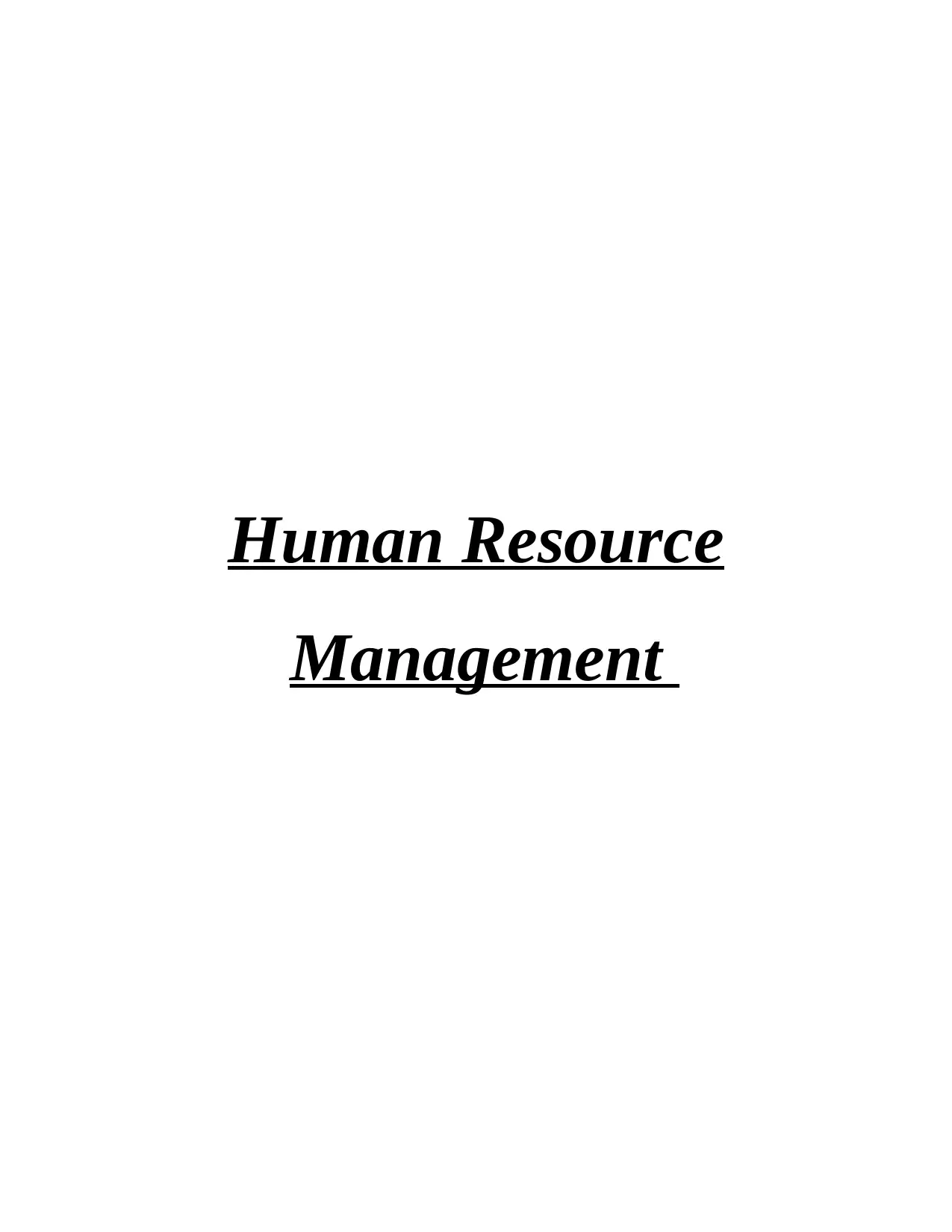
Human Resource
Management
Management
Paraphrase This Document
Need a fresh take? Get an instant paraphrase of this document with our AI Paraphraser
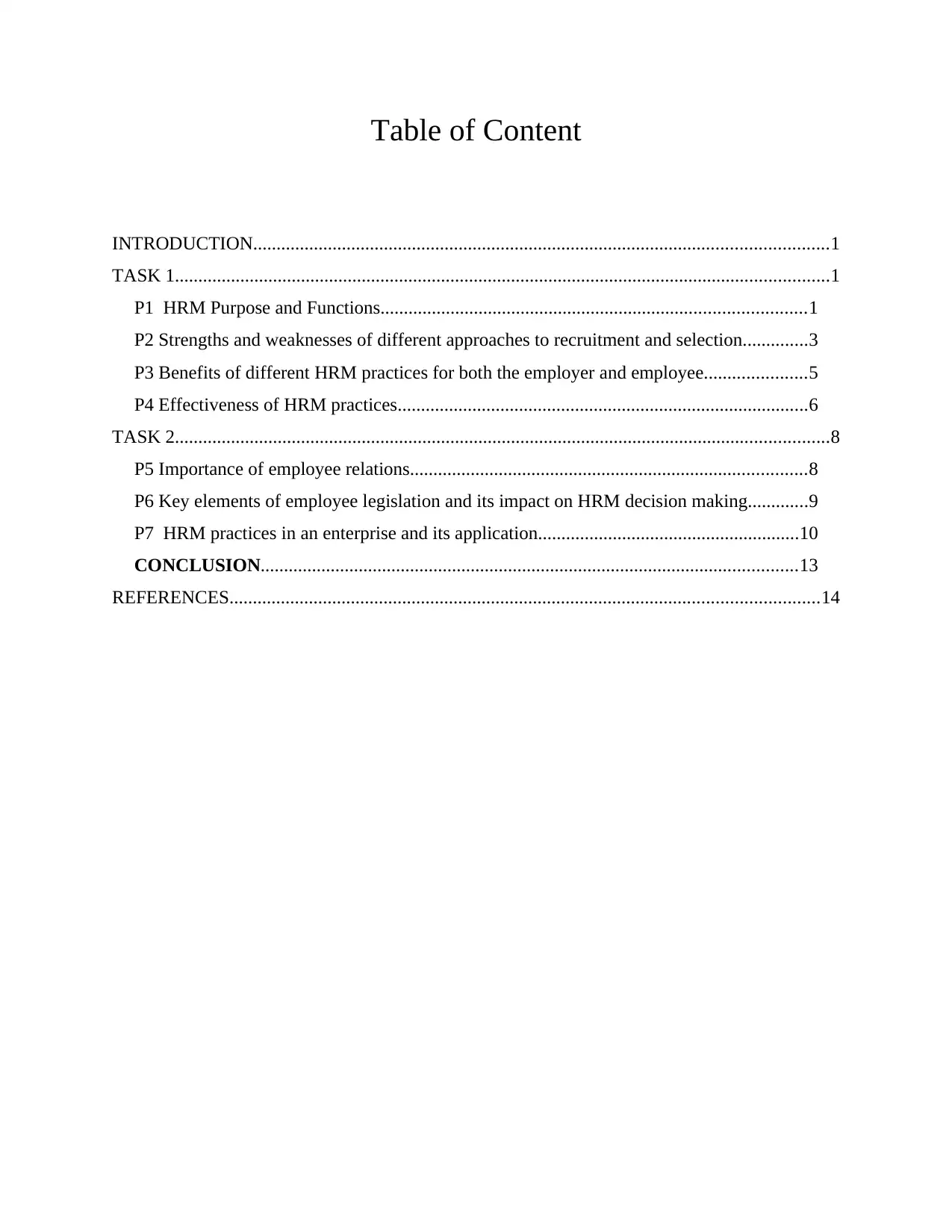
Table of Content
INTRODUCTION...........................................................................................................................1
TASK 1............................................................................................................................................1
P1 HRM Purpose and Functions...........................................................................................1
P2 Strengths and weaknesses of different approaches to recruitment and selection..............3
P3 Benefits of different HRM practices for both the employer and employee......................5
P4 Effectiveness of HRM practices........................................................................................6
TASK 2............................................................................................................................................8
P5 Importance of employee relations.....................................................................................8
P6 Key elements of employee legislation and its impact on HRM decision making.............9
P7 HRM practices in an enterprise and its application........................................................10
CONCLUSION...................................................................................................................13
REFERENCES..............................................................................................................................14
INTRODUCTION...........................................................................................................................1
TASK 1............................................................................................................................................1
P1 HRM Purpose and Functions...........................................................................................1
P2 Strengths and weaknesses of different approaches to recruitment and selection..............3
P3 Benefits of different HRM practices for both the employer and employee......................5
P4 Effectiveness of HRM practices........................................................................................6
TASK 2............................................................................................................................................8
P5 Importance of employee relations.....................................................................................8
P6 Key elements of employee legislation and its impact on HRM decision making.............9
P7 HRM practices in an enterprise and its application........................................................10
CONCLUSION...................................................................................................................13
REFERENCES..............................................................................................................................14
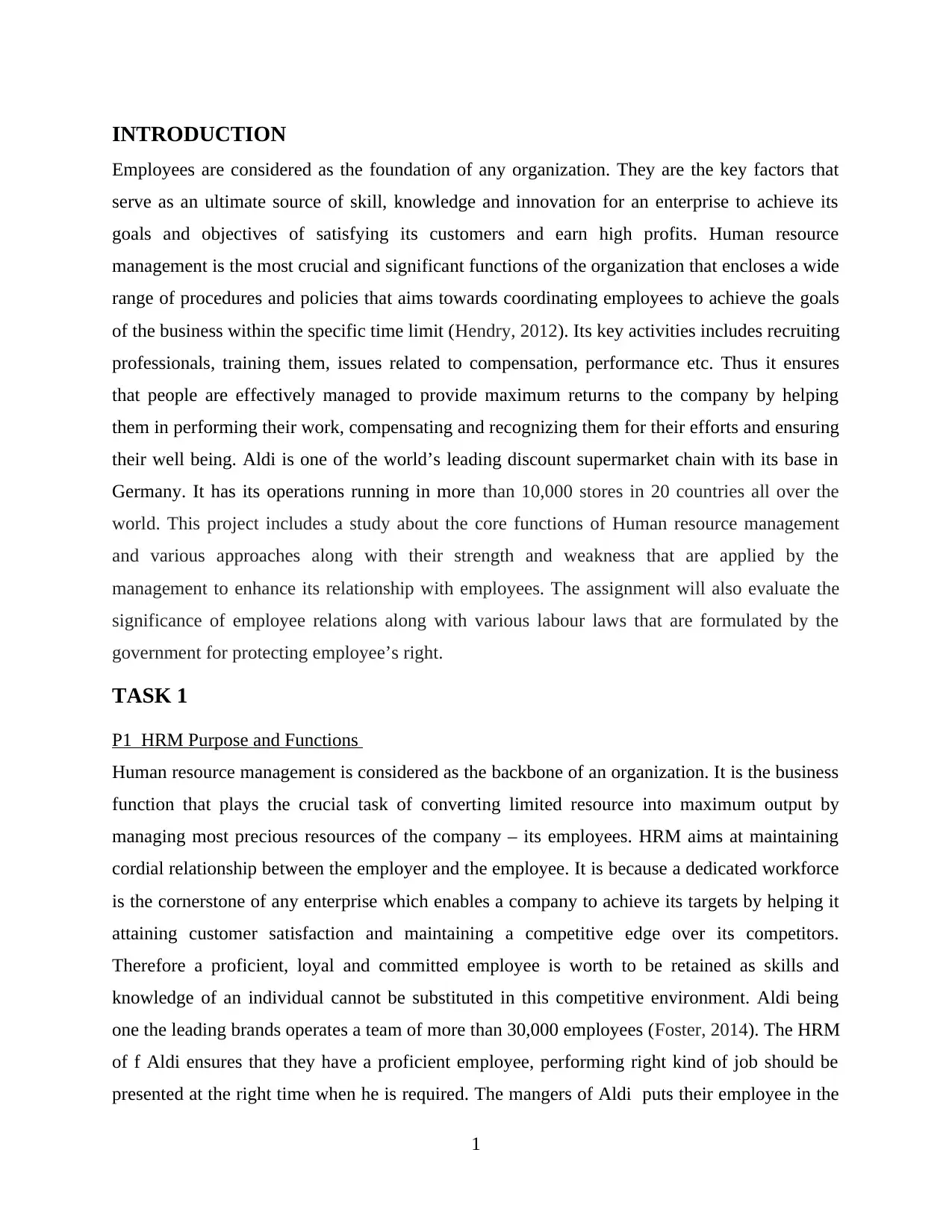
INTRODUCTION
Employees are considered as the foundation of any organization. They are the key factors that
serve as an ultimate source of skill, knowledge and innovation for an enterprise to achieve its
goals and objectives of satisfying its customers and earn high profits. Human resource
management is the most crucial and significant functions of the organization that encloses a wide
range of procedures and policies that aims towards coordinating employees to achieve the goals
of the business within the specific time limit (Hendry, 2012). Its key activities includes recruiting
professionals, training them, issues related to compensation, performance etc. Thus it ensures
that people are effectively managed to provide maximum returns to the company by helping
them in performing their work, compensating and recognizing them for their efforts and ensuring
their well being. Aldi is one of the world’s leading discount supermarket chain with its base in
Germany. It has its operations running in more than 10,000 stores in 20 countries all over the
world. This project includes a study about the core functions of Human resource management
and various approaches along with their strength and weakness that are applied by the
management to enhance its relationship with employees. The assignment will also evaluate the
significance of employee relations along with various labour laws that are formulated by the
government for protecting employee’s right.
TASK 1
P1 HRM Purpose and Functions
Human resource management is considered as the backbone of an organization. It is the business
function that plays the crucial task of converting limited resource into maximum output by
managing most precious resources of the company – its employees. HRM aims at maintaining
cordial relationship between the employer and the employee. It is because a dedicated workforce
is the cornerstone of any enterprise which enables a company to achieve its targets by helping it
attaining customer satisfaction and maintaining a competitive edge over its competitors.
Therefore a proficient, loyal and committed employee is worth to be retained as skills and
knowledge of an individual cannot be substituted in this competitive environment. Aldi being
one the leading brands operates a team of more than 30,000 employees (Foster, 2014). The HRM
of f Aldi ensures that they have a proficient employee, performing right kind of job should be
presented at the right time when he is required. The mangers of Aldi puts their employee in the
1
Employees are considered as the foundation of any organization. They are the key factors that
serve as an ultimate source of skill, knowledge and innovation for an enterprise to achieve its
goals and objectives of satisfying its customers and earn high profits. Human resource
management is the most crucial and significant functions of the organization that encloses a wide
range of procedures and policies that aims towards coordinating employees to achieve the goals
of the business within the specific time limit (Hendry, 2012). Its key activities includes recruiting
professionals, training them, issues related to compensation, performance etc. Thus it ensures
that people are effectively managed to provide maximum returns to the company by helping
them in performing their work, compensating and recognizing them for their efforts and ensuring
their well being. Aldi is one of the world’s leading discount supermarket chain with its base in
Germany. It has its operations running in more than 10,000 stores in 20 countries all over the
world. This project includes a study about the core functions of Human resource management
and various approaches along with their strength and weakness that are applied by the
management to enhance its relationship with employees. The assignment will also evaluate the
significance of employee relations along with various labour laws that are formulated by the
government for protecting employee’s right.
TASK 1
P1 HRM Purpose and Functions
Human resource management is considered as the backbone of an organization. It is the business
function that plays the crucial task of converting limited resource into maximum output by
managing most precious resources of the company – its employees. HRM aims at maintaining
cordial relationship between the employer and the employee. It is because a dedicated workforce
is the cornerstone of any enterprise which enables a company to achieve its targets by helping it
attaining customer satisfaction and maintaining a competitive edge over its competitors.
Therefore a proficient, loyal and committed employee is worth to be retained as skills and
knowledge of an individual cannot be substituted in this competitive environment. Aldi being
one the leading brands operates a team of more than 30,000 employees (Foster, 2014). The HRM
of f Aldi ensures that they have a proficient employee, performing right kind of job should be
presented at the right time when he is required. The mangers of Aldi puts their employee in the
1
⊘ This is a preview!⊘
Do you want full access?
Subscribe today to unlock all pages.

Trusted by 1+ million students worldwide
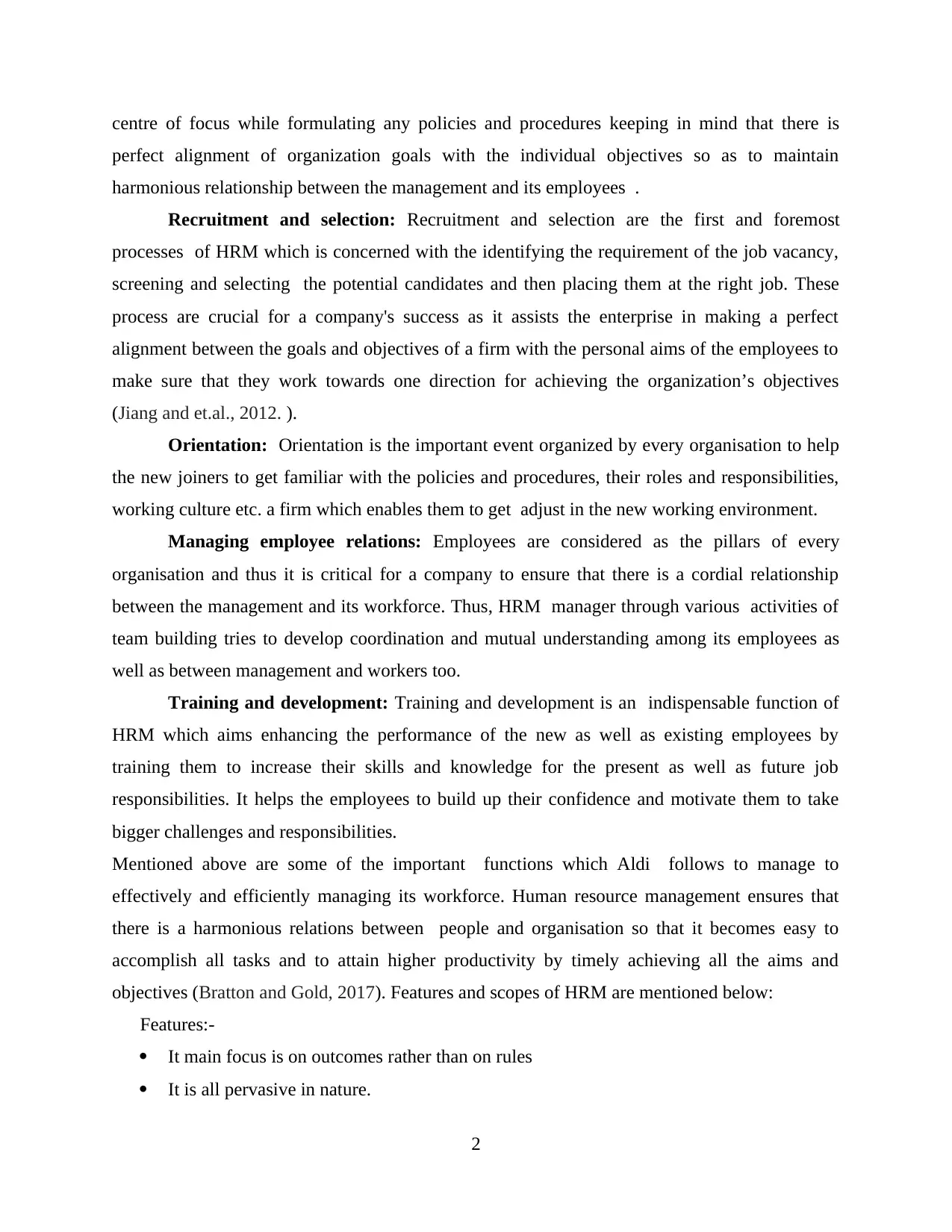
centre of focus while formulating any policies and procedures keeping in mind that there is
perfect alignment of organization goals with the individual objectives so as to maintain
harmonious relationship between the management and its employees .
Recruitment and selection: Recruitment and selection are the first and foremost
processes of HRM which is concerned with the identifying the requirement of the job vacancy,
screening and selecting the potential candidates and then placing them at the right job. These
process are crucial for a company's success as it assists the enterprise in making a perfect
alignment between the goals and objectives of a firm with the personal aims of the employees to
make sure that they work towards one direction for achieving the organization’s objectives
(Jiang and et.al., 2012. ).
Orientation: Orientation is the important event organized by every organisation to help
the new joiners to get familiar with the policies and procedures, their roles and responsibilities,
working culture etc. a firm which enables them to get adjust in the new working environment.
Managing employee relations: Employees are considered as the pillars of every
organisation and thus it is critical for a company to ensure that there is a cordial relationship
between the management and its workforce. Thus, HRM manager through various activities of
team building tries to develop coordination and mutual understanding among its employees as
well as between management and workers too.
Training and development: Training and development is an indispensable function of
HRM which aims enhancing the performance of the new as well as existing employees by
training them to increase their skills and knowledge for the present as well as future job
responsibilities. It helps the employees to build up their confidence and motivate them to take
bigger challenges and responsibilities.
Mentioned above are some of the important functions which Aldi follows to manage to
effectively and efficiently managing its workforce. Human resource management ensures that
there is a harmonious relations between people and organisation so that it becomes easy to
accomplish all tasks and to attain higher productivity by timely achieving all the aims and
objectives (Bratton and Gold, 2017). Features and scopes of HRM are mentioned below:
Features:-
It main focus is on outcomes rather than on rules
It is all pervasive in nature.
2
perfect alignment of organization goals with the individual objectives so as to maintain
harmonious relationship between the management and its employees .
Recruitment and selection: Recruitment and selection are the first and foremost
processes of HRM which is concerned with the identifying the requirement of the job vacancy,
screening and selecting the potential candidates and then placing them at the right job. These
process are crucial for a company's success as it assists the enterprise in making a perfect
alignment between the goals and objectives of a firm with the personal aims of the employees to
make sure that they work towards one direction for achieving the organization’s objectives
(Jiang and et.al., 2012. ).
Orientation: Orientation is the important event organized by every organisation to help
the new joiners to get familiar with the policies and procedures, their roles and responsibilities,
working culture etc. a firm which enables them to get adjust in the new working environment.
Managing employee relations: Employees are considered as the pillars of every
organisation and thus it is critical for a company to ensure that there is a cordial relationship
between the management and its workforce. Thus, HRM manager through various activities of
team building tries to develop coordination and mutual understanding among its employees as
well as between management and workers too.
Training and development: Training and development is an indispensable function of
HRM which aims enhancing the performance of the new as well as existing employees by
training them to increase their skills and knowledge for the present as well as future job
responsibilities. It helps the employees to build up their confidence and motivate them to take
bigger challenges and responsibilities.
Mentioned above are some of the important functions which Aldi follows to manage to
effectively and efficiently managing its workforce. Human resource management ensures that
there is a harmonious relations between people and organisation so that it becomes easy to
accomplish all tasks and to attain higher productivity by timely achieving all the aims and
objectives (Bratton and Gold, 2017). Features and scopes of HRM are mentioned below:
Features:-
It main focus is on outcomes rather than on rules
It is all pervasive in nature.
2
Paraphrase This Document
Need a fresh take? Get an instant paraphrase of this document with our AI Paraphraser
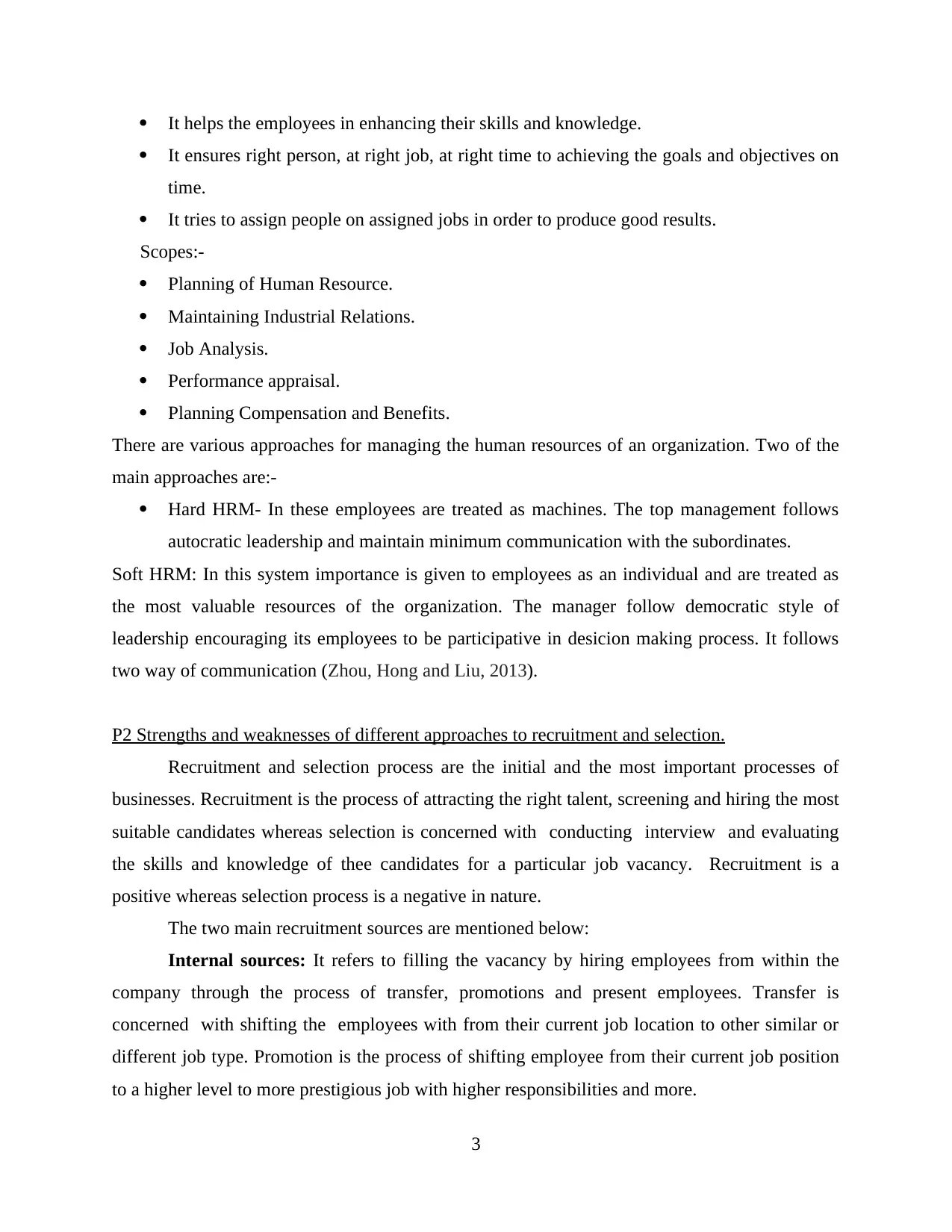
It helps the employees in enhancing their skills and knowledge.
It ensures right person, at right job, at right time to achieving the goals and objectives on
time.
It tries to assign people on assigned jobs in order to produce good results.
Scopes:-
Planning of Human Resource.
Maintaining Industrial Relations.
Job Analysis.
Performance appraisal.
Planning Compensation and Benefits.
There are various approaches for managing the human resources of an organization. Two of the
main approaches are:-
Hard HRM- In these employees are treated as machines. The top management follows
autocratic leadership and maintain minimum communication with the subordinates.
Soft HRM: In this system importance is given to employees as an individual and are treated as
the most valuable resources of the organization. The manager follow democratic style of
leadership encouraging its employees to be participative in desicion making process. It follows
two way of communication (Zhou, Hong and Liu, 2013).
P2 Strengths and weaknesses of different approaches to recruitment and selection.
Recruitment and selection process are the initial and the most important processes of
businesses. Recruitment is the process of attracting the right talent, screening and hiring the most
suitable candidates whereas selection is concerned with conducting interview and evaluating
the skills and knowledge of thee candidates for a particular job vacancy. Recruitment is a
positive whereas selection process is a negative in nature.
The two main recruitment sources are mentioned below:
Internal sources: It refers to filling the vacancy by hiring employees from within the
company through the process of transfer, promotions and present employees. Transfer is
concerned with shifting the employees with from their current job location to other similar or
different job type. Promotion is the process of shifting employee from their current job position
to a higher level to more prestigious job with higher responsibilities and more.
3
It ensures right person, at right job, at right time to achieving the goals and objectives on
time.
It tries to assign people on assigned jobs in order to produce good results.
Scopes:-
Planning of Human Resource.
Maintaining Industrial Relations.
Job Analysis.
Performance appraisal.
Planning Compensation and Benefits.
There are various approaches for managing the human resources of an organization. Two of the
main approaches are:-
Hard HRM- In these employees are treated as machines. The top management follows
autocratic leadership and maintain minimum communication with the subordinates.
Soft HRM: In this system importance is given to employees as an individual and are treated as
the most valuable resources of the organization. The manager follow democratic style of
leadership encouraging its employees to be participative in desicion making process. It follows
two way of communication (Zhou, Hong and Liu, 2013).
P2 Strengths and weaknesses of different approaches to recruitment and selection.
Recruitment and selection process are the initial and the most important processes of
businesses. Recruitment is the process of attracting the right talent, screening and hiring the most
suitable candidates whereas selection is concerned with conducting interview and evaluating
the skills and knowledge of thee candidates for a particular job vacancy. Recruitment is a
positive whereas selection process is a negative in nature.
The two main recruitment sources are mentioned below:
Internal sources: It refers to filling the vacancy by hiring employees from within the
company through the process of transfer, promotions and present employees. Transfer is
concerned with shifting the employees with from their current job location to other similar or
different job type. Promotion is the process of shifting employee from their current job position
to a higher level to more prestigious job with higher responsibilities and more.
3
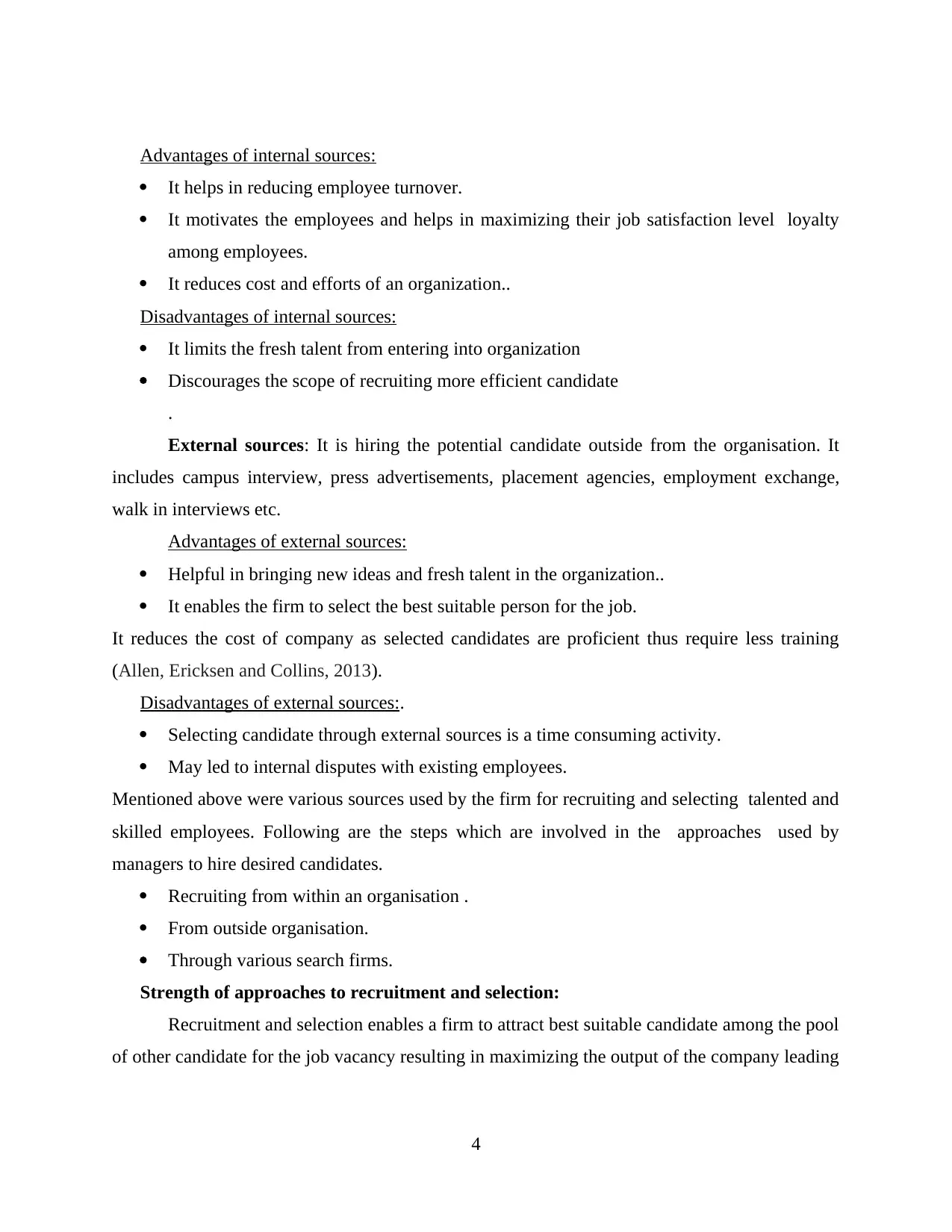
Advantages of internal sources:
It helps in reducing employee turnover.
It motivates the employees and helps in maximizing their job satisfaction level loyalty
among employees.
It reduces cost and efforts of an organization..
Disadvantages of internal sources:
It limits the fresh talent from entering into organization
Discourages the scope of recruiting more efficient candidate
.
External sources: It is hiring the potential candidate outside from the organisation. It
includes campus interview, press advertisements, placement agencies, employment exchange,
walk in interviews etc.
Advantages of external sources:
Helpful in bringing new ideas and fresh talent in the organization..
It enables the firm to select the best suitable person for the job.
It reduces the cost of company as selected candidates are proficient thus require less training
(Allen, Ericksen and Collins, 2013).
Disadvantages of external sources:.
Selecting candidate through external sources is a time consuming activity.
May led to internal disputes with existing employees.
Mentioned above were various sources used by the firm for recruiting and selecting talented and
skilled employees. Following are the steps which are involved in the approaches used by
managers to hire desired candidates.
Recruiting from within an organisation .
From outside organisation.
Through various search firms.
Strength of approaches to recruitment and selection:
Recruitment and selection enables a firm to attract best suitable candidate among the pool
of other candidate for the job vacancy resulting in maximizing the output of the company leading
4
It helps in reducing employee turnover.
It motivates the employees and helps in maximizing their job satisfaction level loyalty
among employees.
It reduces cost and efforts of an organization..
Disadvantages of internal sources:
It limits the fresh talent from entering into organization
Discourages the scope of recruiting more efficient candidate
.
External sources: It is hiring the potential candidate outside from the organisation. It
includes campus interview, press advertisements, placement agencies, employment exchange,
walk in interviews etc.
Advantages of external sources:
Helpful in bringing new ideas and fresh talent in the organization..
It enables the firm to select the best suitable person for the job.
It reduces the cost of company as selected candidates are proficient thus require less training
(Allen, Ericksen and Collins, 2013).
Disadvantages of external sources:.
Selecting candidate through external sources is a time consuming activity.
May led to internal disputes with existing employees.
Mentioned above were various sources used by the firm for recruiting and selecting talented and
skilled employees. Following are the steps which are involved in the approaches used by
managers to hire desired candidates.
Recruiting from within an organisation .
From outside organisation.
Through various search firms.
Strength of approaches to recruitment and selection:
Recruitment and selection enables a firm to attract best suitable candidate among the pool
of other candidate for the job vacancy resulting in maximizing the output of the company leading
4
⊘ This is a preview!⊘
Do you want full access?
Subscribe today to unlock all pages.

Trusted by 1+ million students worldwide
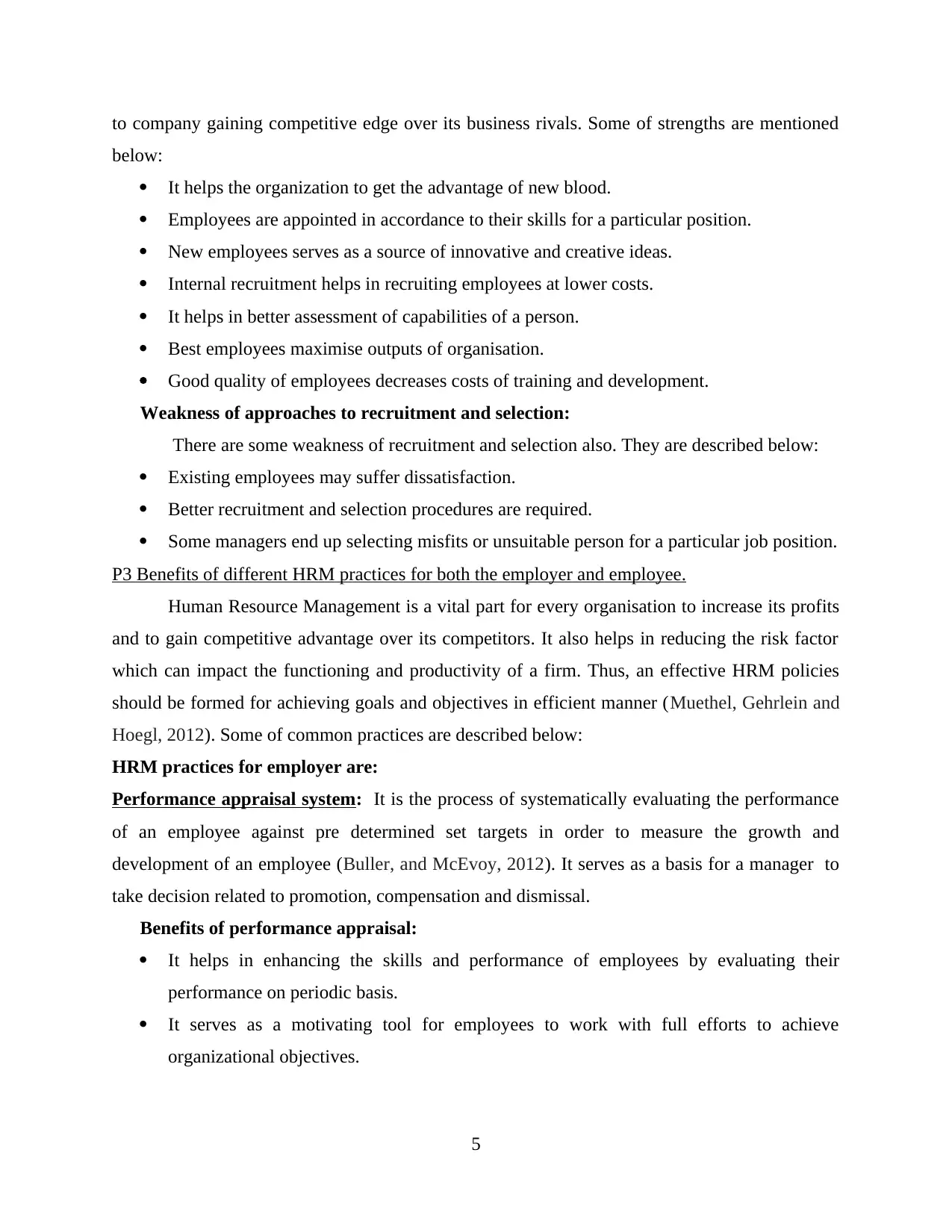
to company gaining competitive edge over its business rivals. Some of strengths are mentioned
below:
It helps the organization to get the advantage of new blood.
Employees are appointed in accordance to their skills for a particular position.
New employees serves as a source of innovative and creative ideas.
Internal recruitment helps in recruiting employees at lower costs.
It helps in better assessment of capabilities of a person.
Best employees maximise outputs of organisation.
Good quality of employees decreases costs of training and development.
Weakness of approaches to recruitment and selection:
There are some weakness of recruitment and selection also. They are described below:
Existing employees may suffer dissatisfaction.
Better recruitment and selection procedures are required.
Some managers end up selecting misfits or unsuitable person for a particular job position.
P3 Benefits of different HRM practices for both the employer and employee.
Human Resource Management is a vital part for every organisation to increase its profits
and to gain competitive advantage over its competitors. It also helps in reducing the risk factor
which can impact the functioning and productivity of a firm. Thus, an effective HRM policies
should be formed for achieving goals and objectives in efficient manner (Muethel, Gehrlein and
Hoegl, 2012). Some of common practices are described below:
HRM practices for employer are:
Performance appraisal system: It is the process of systematically evaluating the performance
of an employee against pre determined set targets in order to measure the growth and
development of an employee (Buller, and McEvoy, 2012). It serves as a basis for a manager to
take decision related to promotion, compensation and dismissal.
Benefits of performance appraisal:
It helps in enhancing the skills and performance of employees by evaluating their
performance on periodic basis.
It serves as a motivating tool for employees to work with full efforts to achieve
organizational objectives.
5
below:
It helps the organization to get the advantage of new blood.
Employees are appointed in accordance to their skills for a particular position.
New employees serves as a source of innovative and creative ideas.
Internal recruitment helps in recruiting employees at lower costs.
It helps in better assessment of capabilities of a person.
Best employees maximise outputs of organisation.
Good quality of employees decreases costs of training and development.
Weakness of approaches to recruitment and selection:
There are some weakness of recruitment and selection also. They are described below:
Existing employees may suffer dissatisfaction.
Better recruitment and selection procedures are required.
Some managers end up selecting misfits or unsuitable person for a particular job position.
P3 Benefits of different HRM practices for both the employer and employee.
Human Resource Management is a vital part for every organisation to increase its profits
and to gain competitive advantage over its competitors. It also helps in reducing the risk factor
which can impact the functioning and productivity of a firm. Thus, an effective HRM policies
should be formed for achieving goals and objectives in efficient manner (Muethel, Gehrlein and
Hoegl, 2012). Some of common practices are described below:
HRM practices for employer are:
Performance appraisal system: It is the process of systematically evaluating the performance
of an employee against pre determined set targets in order to measure the growth and
development of an employee (Buller, and McEvoy, 2012). It serves as a basis for a manager to
take decision related to promotion, compensation and dismissal.
Benefits of performance appraisal:
It helps in enhancing the skills and performance of employees by evaluating their
performance on periodic basis.
It serves as a motivating tool for employees to work with full efforts to achieve
organizational objectives.
5
Paraphrase This Document
Need a fresh take? Get an instant paraphrase of this document with our AI Paraphraser
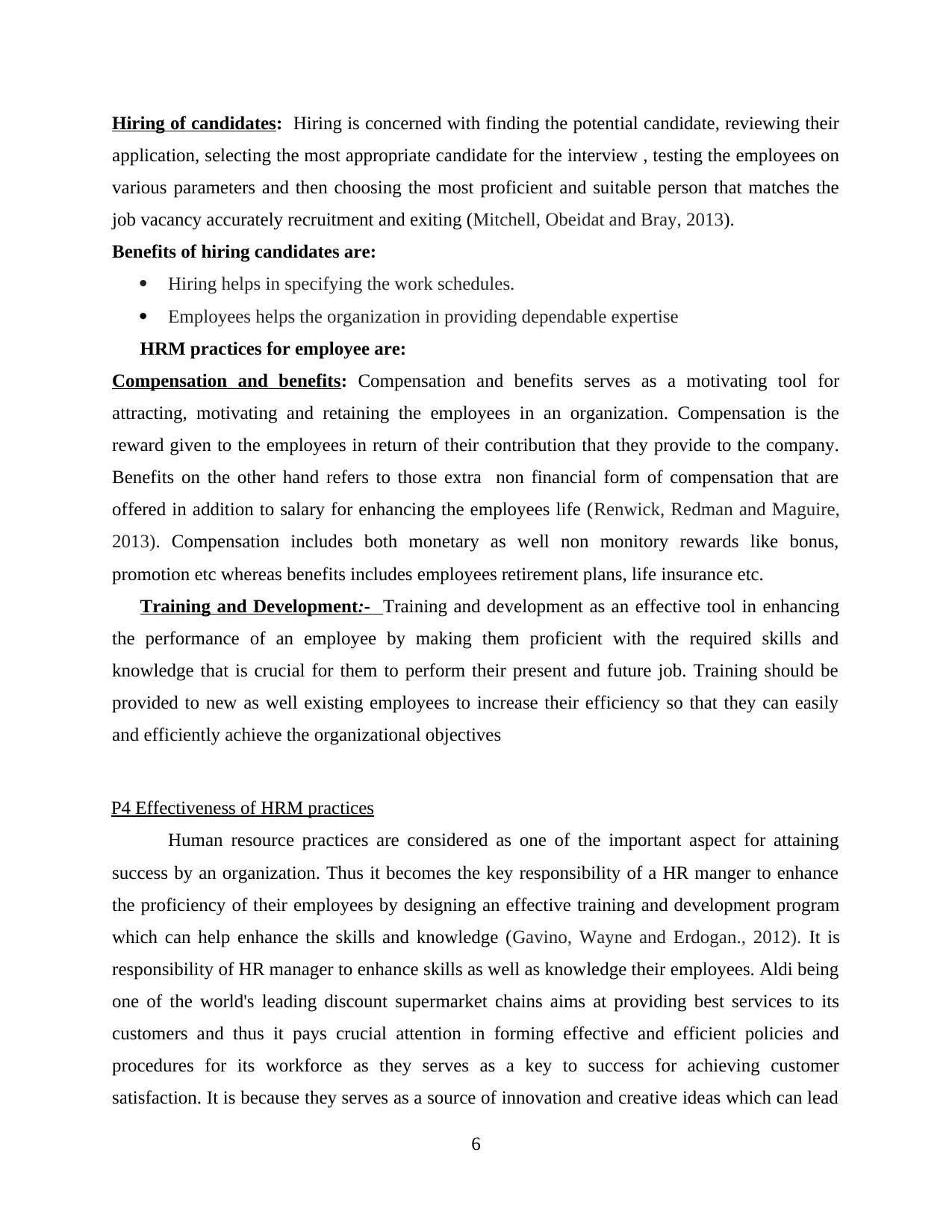
Hiring of candidates: Hiring is concerned with finding the potential candidate, reviewing their
application, selecting the most appropriate candidate for the interview , testing the employees on
various parameters and then choosing the most proficient and suitable person that matches the
job vacancy accurately recruitment and exiting (Mitchell, Obeidat and Bray, 2013).
Benefits of hiring candidates are:
Hiring helps in specifying the work schedules.
Employees helps the organization in providing dependable expertise
HRM practices for employee are:
Compensation and benefits: Compensation and benefits serves as a motivating tool for
attracting, motivating and retaining the employees in an organization. Compensation is the
reward given to the employees in return of their contribution that they provide to the company.
Benefits on the other hand refers to those extra non financial form of compensation that are
offered in addition to salary for enhancing the employees life (Renwick, Redman and Maguire,
2013). Compensation includes both monetary as well non monitory rewards like bonus,
promotion etc whereas benefits includes employees retirement plans, life insurance etc.
Training and Development:- Training and development as an effective tool in enhancing
the performance of an employee by making them proficient with the required skills and
knowledge that is crucial for them to perform their present and future job. Training should be
provided to new as well existing employees to increase their efficiency so that they can easily
and efficiently achieve the organizational objectives
P4 Effectiveness of HRM practices
Human resource practices are considered as one of the important aspect for attaining
success by an organization. Thus it becomes the key responsibility of a HR manger to enhance
the proficiency of their employees by designing an effective training and development program
which can help enhance the skills and knowledge (Gavino, Wayne and Erdogan., 2012). It is
responsibility of HR manager to enhance skills as well as knowledge their employees. Aldi being
one of the world's leading discount supermarket chains aims at providing best services to its
customers and thus it pays crucial attention in forming effective and efficient policies and
procedures for its workforce as they serves as a key to success for achieving customer
satisfaction. It is because they serves as a source of innovation and creative ideas which can lead
6
application, selecting the most appropriate candidate for the interview , testing the employees on
various parameters and then choosing the most proficient and suitable person that matches the
job vacancy accurately recruitment and exiting (Mitchell, Obeidat and Bray, 2013).
Benefits of hiring candidates are:
Hiring helps in specifying the work schedules.
Employees helps the organization in providing dependable expertise
HRM practices for employee are:
Compensation and benefits: Compensation and benefits serves as a motivating tool for
attracting, motivating and retaining the employees in an organization. Compensation is the
reward given to the employees in return of their contribution that they provide to the company.
Benefits on the other hand refers to those extra non financial form of compensation that are
offered in addition to salary for enhancing the employees life (Renwick, Redman and Maguire,
2013). Compensation includes both monetary as well non monitory rewards like bonus,
promotion etc whereas benefits includes employees retirement plans, life insurance etc.
Training and Development:- Training and development as an effective tool in enhancing
the performance of an employee by making them proficient with the required skills and
knowledge that is crucial for them to perform their present and future job. Training should be
provided to new as well existing employees to increase their efficiency so that they can easily
and efficiently achieve the organizational objectives
P4 Effectiveness of HRM practices
Human resource practices are considered as one of the important aspect for attaining
success by an organization. Thus it becomes the key responsibility of a HR manger to enhance
the proficiency of their employees by designing an effective training and development program
which can help enhance the skills and knowledge (Gavino, Wayne and Erdogan., 2012). It is
responsibility of HR manager to enhance skills as well as knowledge their employees. Aldi being
one of the world's leading discount supermarket chains aims at providing best services to its
customers and thus it pays crucial attention in forming effective and efficient policies and
procedures for its workforce as they serves as a key to success for achieving customer
satisfaction. It is because they serves as a source of innovation and creative ideas which can lead
6
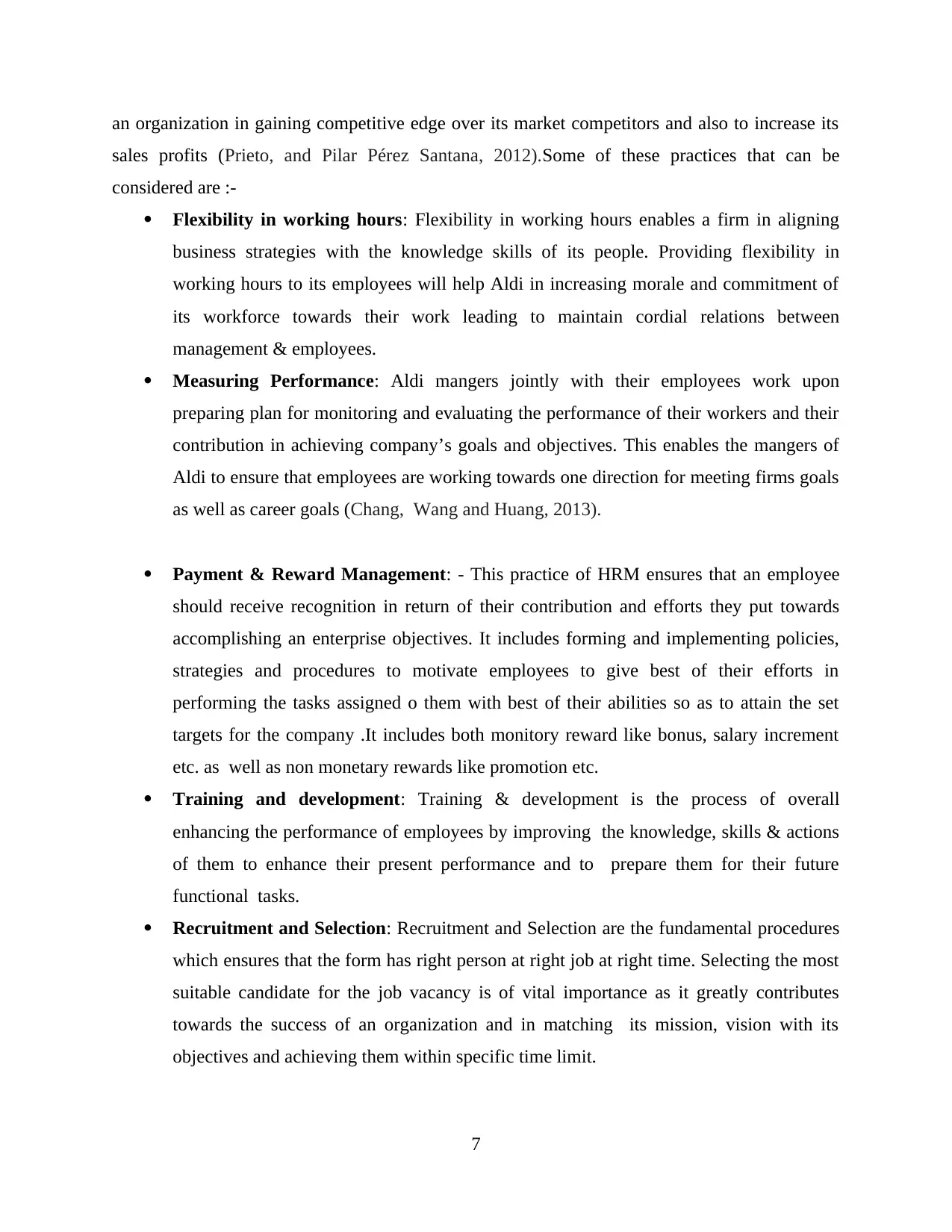
an organization in gaining competitive edge over its market competitors and also to increase its
sales profits (Prieto, and Pilar Pérez Santana, 2012).Some of these practices that can be
considered are :-
Flexibility in working hours: Flexibility in working hours enables a firm in aligning
business strategies with the knowledge skills of its people. Providing flexibility in
working hours to its employees will help Aldi in increasing morale and commitment of
its workforce towards their work leading to maintain cordial relations between
management & employees.
Measuring Performance: Aldi mangers jointly with their employees work upon
preparing plan for monitoring and evaluating the performance of their workers and their
contribution in achieving company’s goals and objectives. This enables the mangers of
Aldi to ensure that employees are working towards one direction for meeting firms goals
as well as career goals (Chang, Wang and Huang, 2013).
Payment & Reward Management: - This practice of HRM ensures that an employee
should receive recognition in return of their contribution and efforts they put towards
accomplishing an enterprise objectives. It includes forming and implementing policies,
strategies and procedures to motivate employees to give best of their efforts in
performing the tasks assigned o them with best of their abilities so as to attain the set
targets for the company .It includes both monitory reward like bonus, salary increment
etc. as well as non monetary rewards like promotion etc.
Training and development: Training & development is the process of overall
enhancing the performance of employees by improving the knowledge, skills & actions
of them to enhance their present performance and to prepare them for their future
functional tasks.
Recruitment and Selection: Recruitment and Selection are the fundamental procedures
which ensures that the form has right person at right job at right time. Selecting the most
suitable candidate for the job vacancy is of vital importance as it greatly contributes
towards the success of an organization and in matching its mission, vision with its
objectives and achieving them within specific time limit.
7
sales profits (Prieto, and Pilar Pérez Santana, 2012).Some of these practices that can be
considered are :-
Flexibility in working hours: Flexibility in working hours enables a firm in aligning
business strategies with the knowledge skills of its people. Providing flexibility in
working hours to its employees will help Aldi in increasing morale and commitment of
its workforce towards their work leading to maintain cordial relations between
management & employees.
Measuring Performance: Aldi mangers jointly with their employees work upon
preparing plan for monitoring and evaluating the performance of their workers and their
contribution in achieving company’s goals and objectives. This enables the mangers of
Aldi to ensure that employees are working towards one direction for meeting firms goals
as well as career goals (Chang, Wang and Huang, 2013).
Payment & Reward Management: - This practice of HRM ensures that an employee
should receive recognition in return of their contribution and efforts they put towards
accomplishing an enterprise objectives. It includes forming and implementing policies,
strategies and procedures to motivate employees to give best of their efforts in
performing the tasks assigned o them with best of their abilities so as to attain the set
targets for the company .It includes both monitory reward like bonus, salary increment
etc. as well as non monetary rewards like promotion etc.
Training and development: Training & development is the process of overall
enhancing the performance of employees by improving the knowledge, skills & actions
of them to enhance their present performance and to prepare them for their future
functional tasks.
Recruitment and Selection: Recruitment and Selection are the fundamental procedures
which ensures that the form has right person at right job at right time. Selecting the most
suitable candidate for the job vacancy is of vital importance as it greatly contributes
towards the success of an organization and in matching its mission, vision with its
objectives and achieving them within specific time limit.
7
⊘ This is a preview!⊘
Do you want full access?
Subscribe today to unlock all pages.

Trusted by 1+ million students worldwide
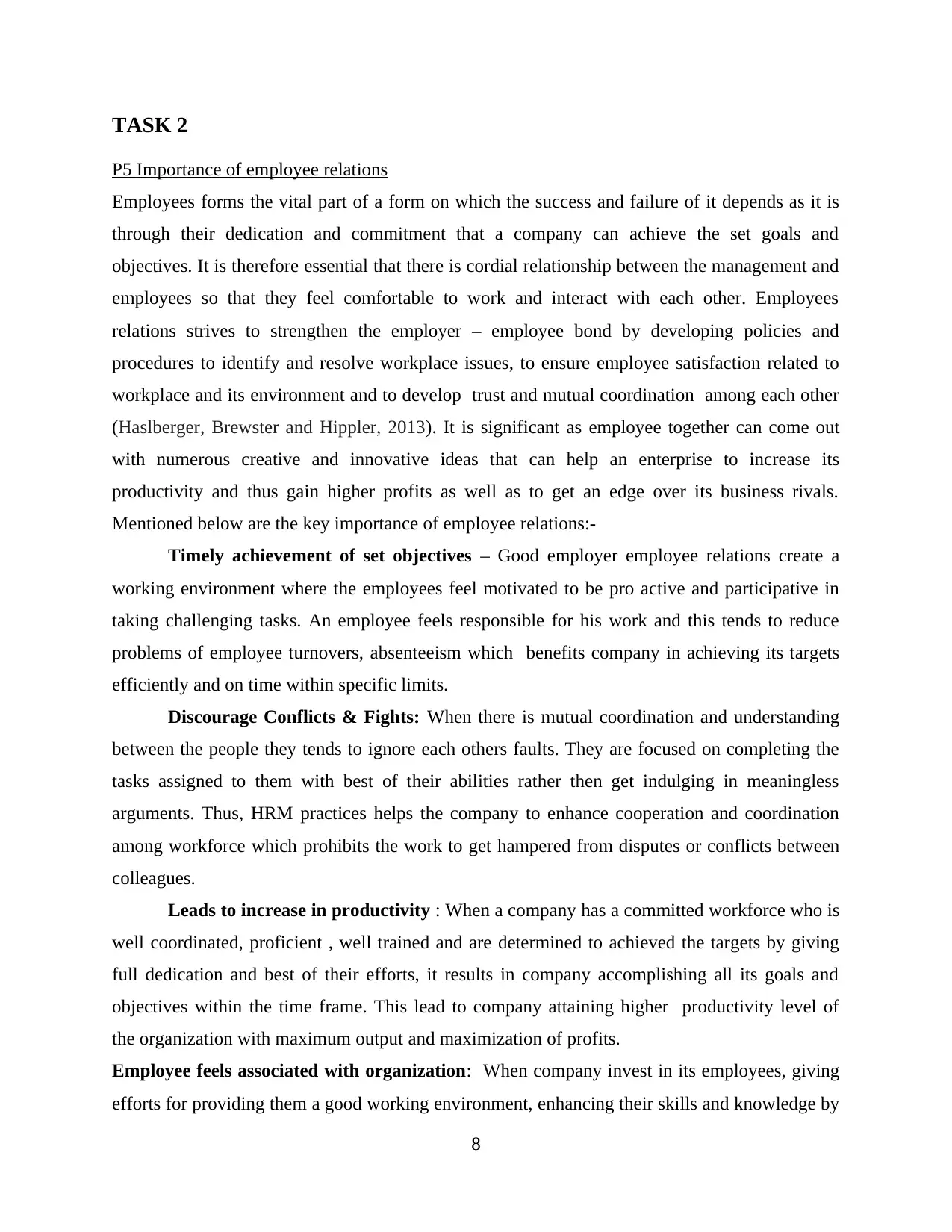
TASK 2
P5 Importance of employee relations
Employees forms the vital part of a form on which the success and failure of it depends as it is
through their dedication and commitment that a company can achieve the set goals and
objectives. It is therefore essential that there is cordial relationship between the management and
employees so that they feel comfortable to work and interact with each other. Employees
relations strives to strengthen the employer – employee bond by developing policies and
procedures to identify and resolve workplace issues, to ensure employee satisfaction related to
workplace and its environment and to develop trust and mutual coordination among each other
(Haslberger, Brewster and Hippler, 2013). It is significant as employee together can come out
with numerous creative and innovative ideas that can help an enterprise to increase its
productivity and thus gain higher profits as well as to get an edge over its business rivals.
Mentioned below are the key importance of employee relations:-
Timely achievement of set objectives – Good employer employee relations create a
working environment where the employees feel motivated to be pro active and participative in
taking challenging tasks. An employee feels responsible for his work and this tends to reduce
problems of employee turnovers, absenteeism which benefits company in achieving its targets
efficiently and on time within specific limits.
Discourage Conflicts & Fights: When there is mutual coordination and understanding
between the people they tends to ignore each others faults. They are focused on completing the
tasks assigned to them with best of their abilities rather then get indulging in meaningless
arguments. Thus, HRM practices helps the company to enhance cooperation and coordination
among workforce which prohibits the work to get hampered from disputes or conflicts between
colleagues.
Leads to increase in productivity : When a company has a committed workforce who is
well coordinated, proficient , well trained and are determined to achieved the targets by giving
full dedication and best of their efforts, it results in company accomplishing all its goals and
objectives within the time frame. This lead to company attaining higher productivity level of
the organization with maximum output and maximization of profits.
Employee feels associated with organization: When company invest in its employees, giving
efforts for providing them a good working environment, enhancing their skills and knowledge by
8
P5 Importance of employee relations
Employees forms the vital part of a form on which the success and failure of it depends as it is
through their dedication and commitment that a company can achieve the set goals and
objectives. It is therefore essential that there is cordial relationship between the management and
employees so that they feel comfortable to work and interact with each other. Employees
relations strives to strengthen the employer – employee bond by developing policies and
procedures to identify and resolve workplace issues, to ensure employee satisfaction related to
workplace and its environment and to develop trust and mutual coordination among each other
(Haslberger, Brewster and Hippler, 2013). It is significant as employee together can come out
with numerous creative and innovative ideas that can help an enterprise to increase its
productivity and thus gain higher profits as well as to get an edge over its business rivals.
Mentioned below are the key importance of employee relations:-
Timely achievement of set objectives – Good employer employee relations create a
working environment where the employees feel motivated to be pro active and participative in
taking challenging tasks. An employee feels responsible for his work and this tends to reduce
problems of employee turnovers, absenteeism which benefits company in achieving its targets
efficiently and on time within specific limits.
Discourage Conflicts & Fights: When there is mutual coordination and understanding
between the people they tends to ignore each others faults. They are focused on completing the
tasks assigned to them with best of their abilities rather then get indulging in meaningless
arguments. Thus, HRM practices helps the company to enhance cooperation and coordination
among workforce which prohibits the work to get hampered from disputes or conflicts between
colleagues.
Leads to increase in productivity : When a company has a committed workforce who is
well coordinated, proficient , well trained and are determined to achieved the targets by giving
full dedication and best of their efforts, it results in company accomplishing all its goals and
objectives within the time frame. This lead to company attaining higher productivity level of
the organization with maximum output and maximization of profits.
Employee feels associated with organization: When company invest in its employees, giving
efforts for providing them a good working environment, enhancing their skills and knowledge by
8
Paraphrase This Document
Need a fresh take? Get an instant paraphrase of this document with our AI Paraphraser
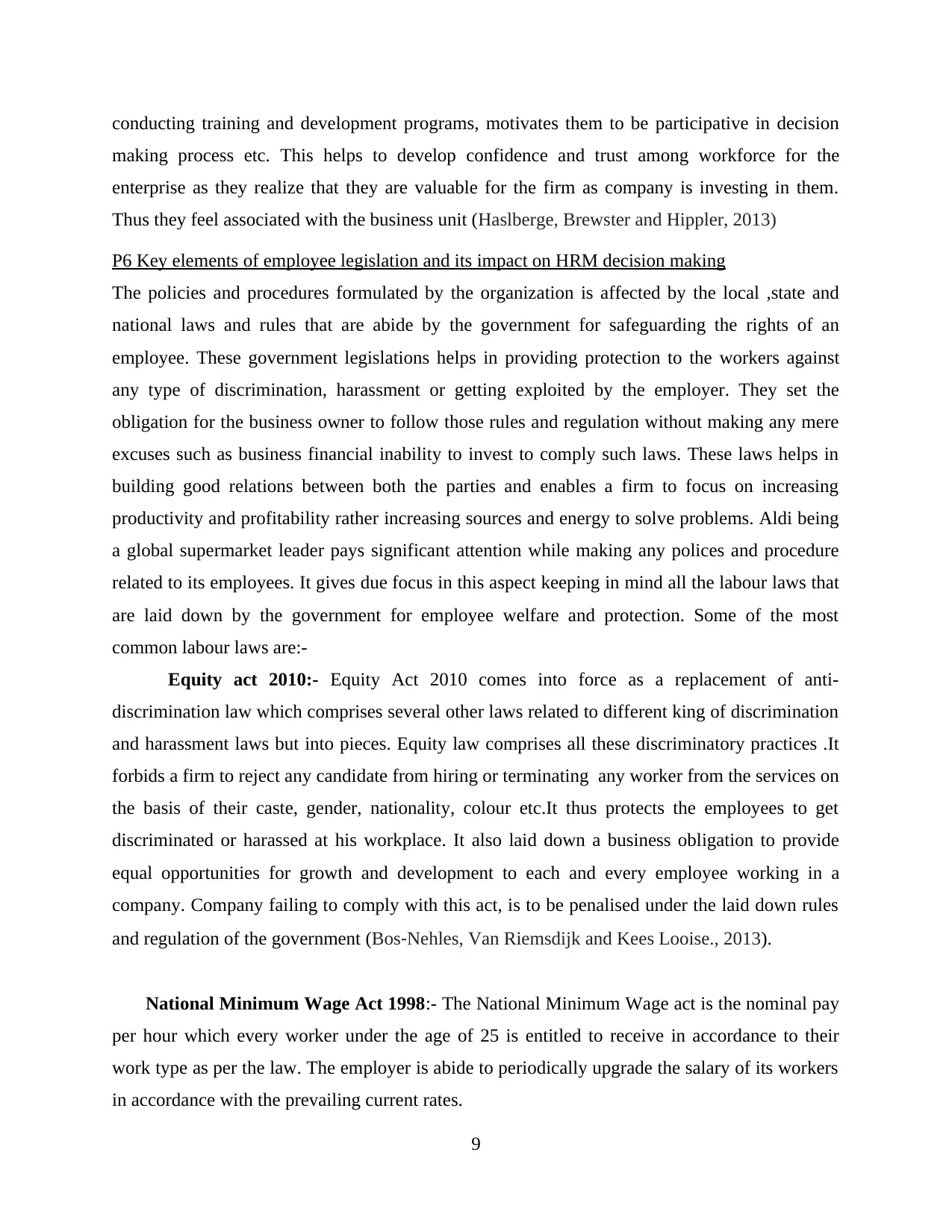
conducting training and development programs, motivates them to be participative in decision
making process etc. This helps to develop confidence and trust among workforce for the
enterprise as they realize that they are valuable for the firm as company is investing in them.
Thus they feel associated with the business unit (Haslberge, Brewster and Hippler, 2013)
P6 Key elements of employee legislation and its impact on HRM decision making
The policies and procedures formulated by the organization is affected by the local ,state and
national laws and rules that are abide by the government for safeguarding the rights of an
employee. These government legislations helps in providing protection to the workers against
any type of discrimination, harassment or getting exploited by the employer. They set the
obligation for the business owner to follow those rules and regulation without making any mere
excuses such as business financial inability to invest to comply such laws. These laws helps in
building good relations between both the parties and enables a firm to focus on increasing
productivity and profitability rather increasing sources and energy to solve problems. Aldi being
a global supermarket leader pays significant attention while making any polices and procedure
related to its employees. It gives due focus in this aspect keeping in mind all the labour laws that
are laid down by the government for employee welfare and protection. Some of the most
common labour laws are:-
Equity act 2010:- Equity Act 2010 comes into force as a replacement of anti-
discrimination law which comprises several other laws related to different king of discrimination
and harassment laws but into pieces. Equity law comprises all these discriminatory practices .It
forbids a firm to reject any candidate from hiring or terminating any worker from the services on
the basis of their caste, gender, nationality, colour etc.It thus protects the employees to get
discriminated or harassed at his workplace. It also laid down a business obligation to provide
equal opportunities for growth and development to each and every employee working in a
company. Company failing to comply with this act, is to be penalised under the laid down rules
and regulation of the government (Bos‐Nehles, Van Riemsdijk and Kees Looise., 2013).
National Minimum Wage Act 1998:- The National Minimum Wage act is the nominal pay
per hour which every worker under the age of 25 is entitled to receive in accordance to their
work type as per the law. The employer is abide to periodically upgrade the salary of its workers
in accordance with the prevailing current rates.
9
making process etc. This helps to develop confidence and trust among workforce for the
enterprise as they realize that they are valuable for the firm as company is investing in them.
Thus they feel associated with the business unit (Haslberge, Brewster and Hippler, 2013)
P6 Key elements of employee legislation and its impact on HRM decision making
The policies and procedures formulated by the organization is affected by the local ,state and
national laws and rules that are abide by the government for safeguarding the rights of an
employee. These government legislations helps in providing protection to the workers against
any type of discrimination, harassment or getting exploited by the employer. They set the
obligation for the business owner to follow those rules and regulation without making any mere
excuses such as business financial inability to invest to comply such laws. These laws helps in
building good relations between both the parties and enables a firm to focus on increasing
productivity and profitability rather increasing sources and energy to solve problems. Aldi being
a global supermarket leader pays significant attention while making any polices and procedure
related to its employees. It gives due focus in this aspect keeping in mind all the labour laws that
are laid down by the government for employee welfare and protection. Some of the most
common labour laws are:-
Equity act 2010:- Equity Act 2010 comes into force as a replacement of anti-
discrimination law which comprises several other laws related to different king of discrimination
and harassment laws but into pieces. Equity law comprises all these discriminatory practices .It
forbids a firm to reject any candidate from hiring or terminating any worker from the services on
the basis of their caste, gender, nationality, colour etc.It thus protects the employees to get
discriminated or harassed at his workplace. It also laid down a business obligation to provide
equal opportunities for growth and development to each and every employee working in a
company. Company failing to comply with this act, is to be penalised under the laid down rules
and regulation of the government (Bos‐Nehles, Van Riemsdijk and Kees Looise., 2013).
National Minimum Wage Act 1998:- The National Minimum Wage act is the nominal pay
per hour which every worker under the age of 25 is entitled to receive in accordance to their
work type as per the law. The employer is abide to periodically upgrade the salary of its workers
in accordance with the prevailing current rates.
9
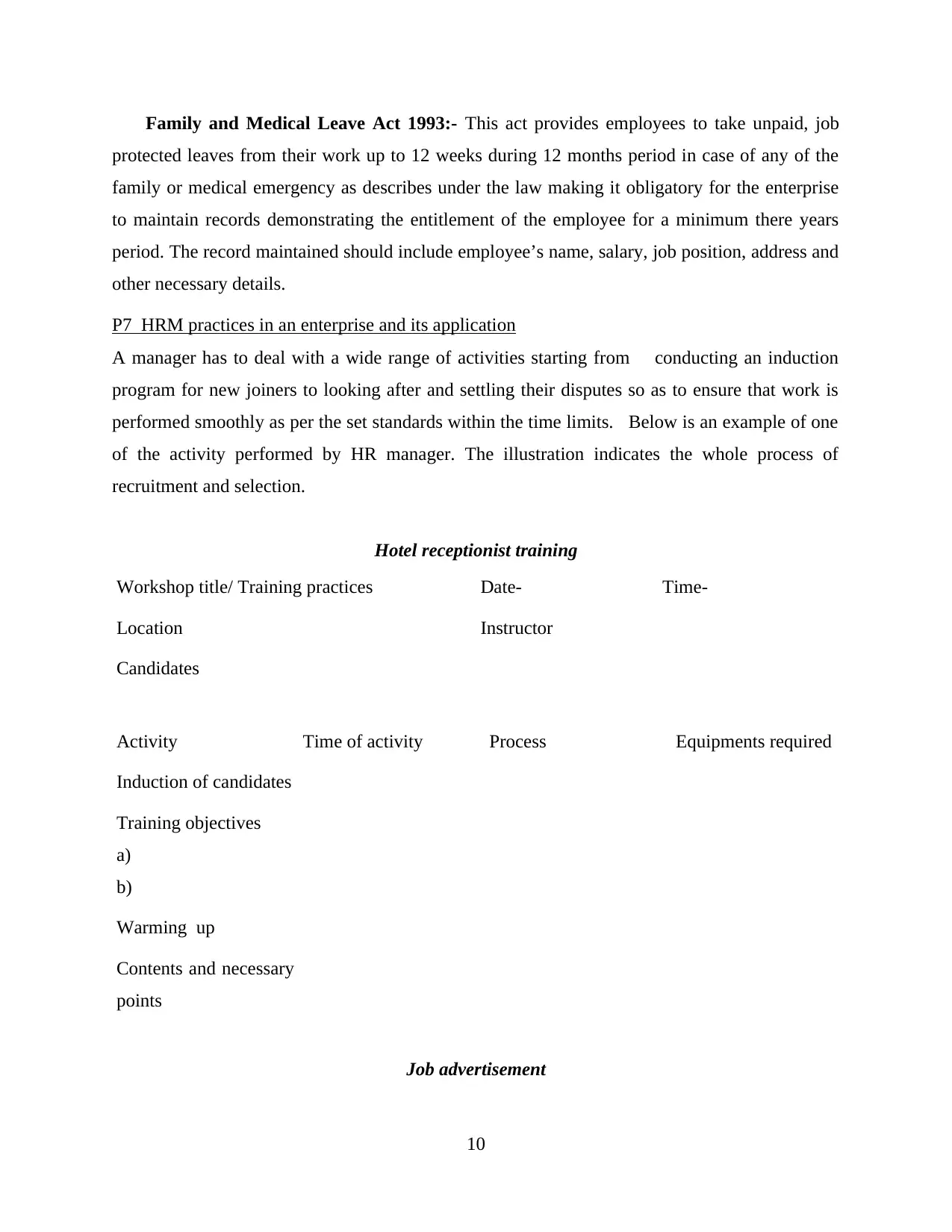
Family and Medical Leave Act 1993:- This act provides employees to take unpaid, job
protected leaves from their work up to 12 weeks during 12 months period in case of any of the
family or medical emergency as describes under the law making it obligatory for the enterprise
to maintain records demonstrating the entitlement of the employee for a minimum there years
period. The record maintained should include employee’s name, salary, job position, address and
other necessary details.
P7 HRM practices in an enterprise and its application
A manager has to deal with a wide range of activities starting from conducting an induction
program for new joiners to looking after and settling their disputes so as to ensure that work is
performed smoothly as per the set standards within the time limits. Below is an example of one
of the activity performed by HR manager. The illustration indicates the whole process of
recruitment and selection.
Hotel receptionist training
Workshop title/ Training practices Date- Time-
Location Instructor
Candidates
Activity Time of activity Process Equipments required
Induction of candidates
Training objectives
a)
b)
Warming up
Contents and necessary
points
Job advertisement
10
protected leaves from their work up to 12 weeks during 12 months period in case of any of the
family or medical emergency as describes under the law making it obligatory for the enterprise
to maintain records demonstrating the entitlement of the employee for a minimum there years
period. The record maintained should include employee’s name, salary, job position, address and
other necessary details.
P7 HRM practices in an enterprise and its application
A manager has to deal with a wide range of activities starting from conducting an induction
program for new joiners to looking after and settling their disputes so as to ensure that work is
performed smoothly as per the set standards within the time limits. Below is an example of one
of the activity performed by HR manager. The illustration indicates the whole process of
recruitment and selection.
Hotel receptionist training
Workshop title/ Training practices Date- Time-
Location Instructor
Candidates
Activity Time of activity Process Equipments required
Induction of candidates
Training objectives
a)
b)
Warming up
Contents and necessary
points
Job advertisement
10
⊘ This is a preview!⊘
Do you want full access?
Subscribe today to unlock all pages.

Trusted by 1+ million students worldwide
1 out of 17
Related Documents
Your All-in-One AI-Powered Toolkit for Academic Success.
+13062052269
info@desklib.com
Available 24*7 on WhatsApp / Email
![[object Object]](/_next/static/media/star-bottom.7253800d.svg)
Unlock your academic potential
Copyright © 2020–2025 A2Z Services. All Rights Reserved. Developed and managed by ZUCOL.





